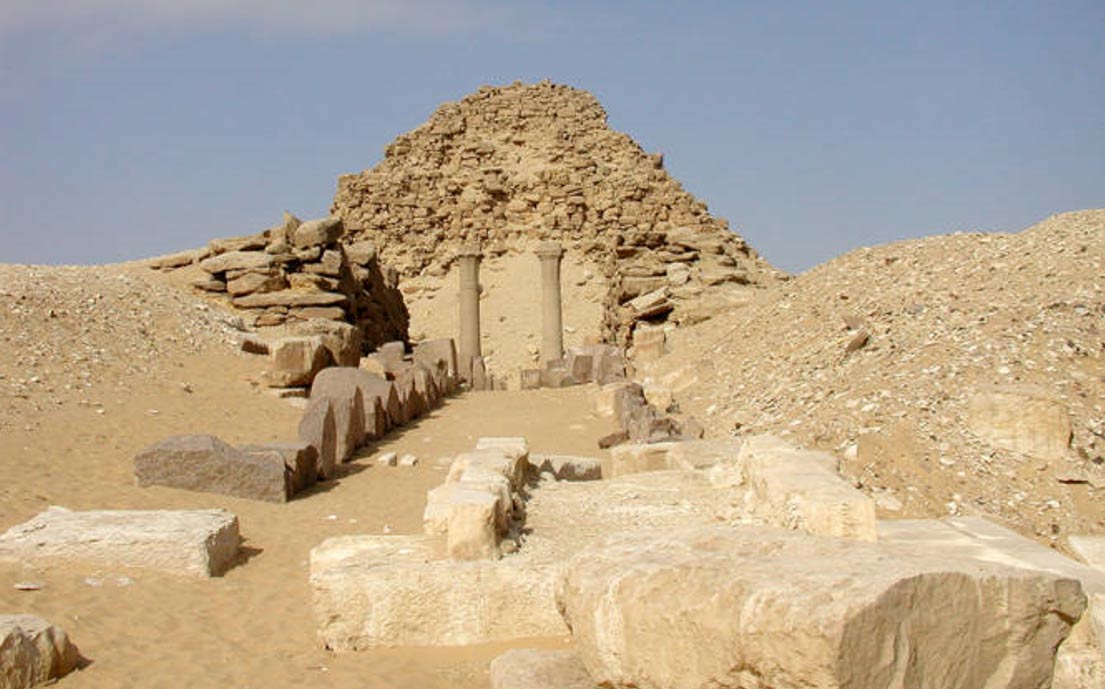Archaeologists find 4,500-year-old statue of little known Egyptian king
A broken statue with the name of King Sahure, a pharaoh who ruled nearly 4,500 years ago, has been excavated in Egypt by Belgian archaeologists. Little is known of King Sahure, who reigned during the Old Kingdom’s Fifth Dynasty.
The find is “of great significance and importance,” said the Egyptian Ministry of Antiquities, particularly as there are only two other intact statues that exist of Sahure. The team of Belgian archaeologists intend to continue excavating in the area with the aim of finding other artifacts pertaining to Sahure.
The other two known statues of Sahure still intact are on display at the Egyptian Museum in Cairo and New York’s Metropolitan Museum.

King Sahure’s name was engraved on the bottom part of a broken statue unearthed by Belgian archaeologists. (Photo by Egyptian Antiquities Ministry)

Gneiss statue of Sahure and a nome god in the Metropolitan Museum of Art in New York City. (Photo by Keith Schengili-Roberts /Wikimedia Commons)
The Ministry of Antiquities said it believes the base, which measures 21cm (8.3 inches) is the bottom half of a larger statue of King Sahure seated on a throne, which probably measured around 70cm (27.6 inch) in height.
The statue was excavated in Egypt’s governate of Aswan, about 580 km (360 miles) south of Cairo. Aswan is the ancient city of Swenett, which in antiquity was the frontier town of Ancient Egypt facing the south.
Sahure’s name means ‘He who is close to Re’. Re, also spelt Ra, was considered to be the god of the sun and a creator god. He ruled for 12 years and was the second king of the Fifth Dynasty. Egyptologists believe he was the first son of Queen Khentkaues. Another of her sons is also believed to have ruled Egypt.
Sahure had the first pyramid complex at Abusir. Many reliefs at the complex are well-done, says Tour Egypt, but it marks the decline in size and quality of pyramids. He also is thought to have built a sun temple but the location of it is not known.
Most foreign relations during the reign of Sahure were economic, rather than combative. In one scene, we find great ships with Egyptians and Asiatics on board. They are returning, we believe, from the port of Byblos in Lebanon with huge cedar trees. For this, we have collaborating evidence in the form of his name on a piece of thin, gold stamped to a chair, as well as other evidence of 5th Dynasty king's cartouches found in Lebanon on stone vessels. Other scenes in his temple depict what we are told are Syrian bears. We also have the first documented expedition to the land of Punt, which apparently yielded a quantity of myrrh, along with malachite and electrum, and because of this, Sahure is often credited with establishing an Egyptian navy. There is also scenes of a raid into Libya which yielded various livestock and showed the king smiting the local chieftains. The Palermo Stone also collaborates some of these events.—Tour Egypt.
Earlier in April 2015, German and Egyptian archaeologists excavating an ancient mud brick temple site in Cairo unearthed part of a chapel used by a pharaoh who came much later than Sahure. Pharaoh Nectanbebo 1 of the 30 th Dynasty of 380 to 340 BC built the chapel in the capital of Heliopolis. The praying area in the temple “consists of carved basalt blocks in addition to a part of a royal statue carrying a cartouche of King Merineptah,” said the Antiquities Ministry. The cartouche shows a song of King Rameses II making an offering to a god. The temple finding is rare in the vicinity of Cairo because stone building materials from ancient structures were used in later projects, in 12 th century AD in Islamic Cairo.
Featured Image: The ruins of Sahure’s pyramid (Photo by John Bodsworth/Wikimedia Commons)
By Mark Miller




















Comments
I would be the first to say that the early Pharaohs were black African, but after a decade of research I have come to the conclusion that they were Northern African of Celtic heritage (until several much later dynasties). As for Sahure, there are many depictions of him that look 100% Caucasian. The Pharaohs often did not depict themselves as they looked in person. It is an idiosyncrasy that is not fully understood. I have many photos of sculpture showing Sahure looking utterly different than this sculpture. I am not a racist, I am however, a Truthist. I have no agenda except to understand who the mysterious first Egyptian kings were. For ANY race to claim them at this time is idiotic. Whatever traces remain of that great people, humans have sunk so far spiritually, morally, and intellectually, no living race can claim them today. This comment section doesn't take photos, but as I said, Sahure was also depicted looking VERY Caucasian. Maybe this puzzle was left for us all so that we don't make it all about race.
Definitely a strong Negro presence, undeniable!!